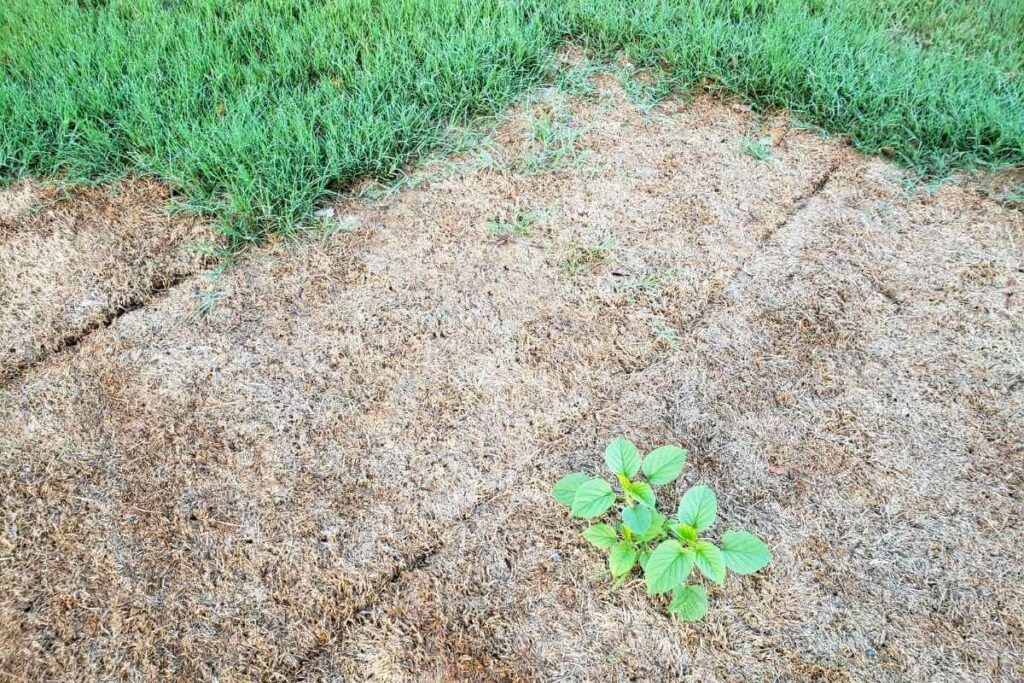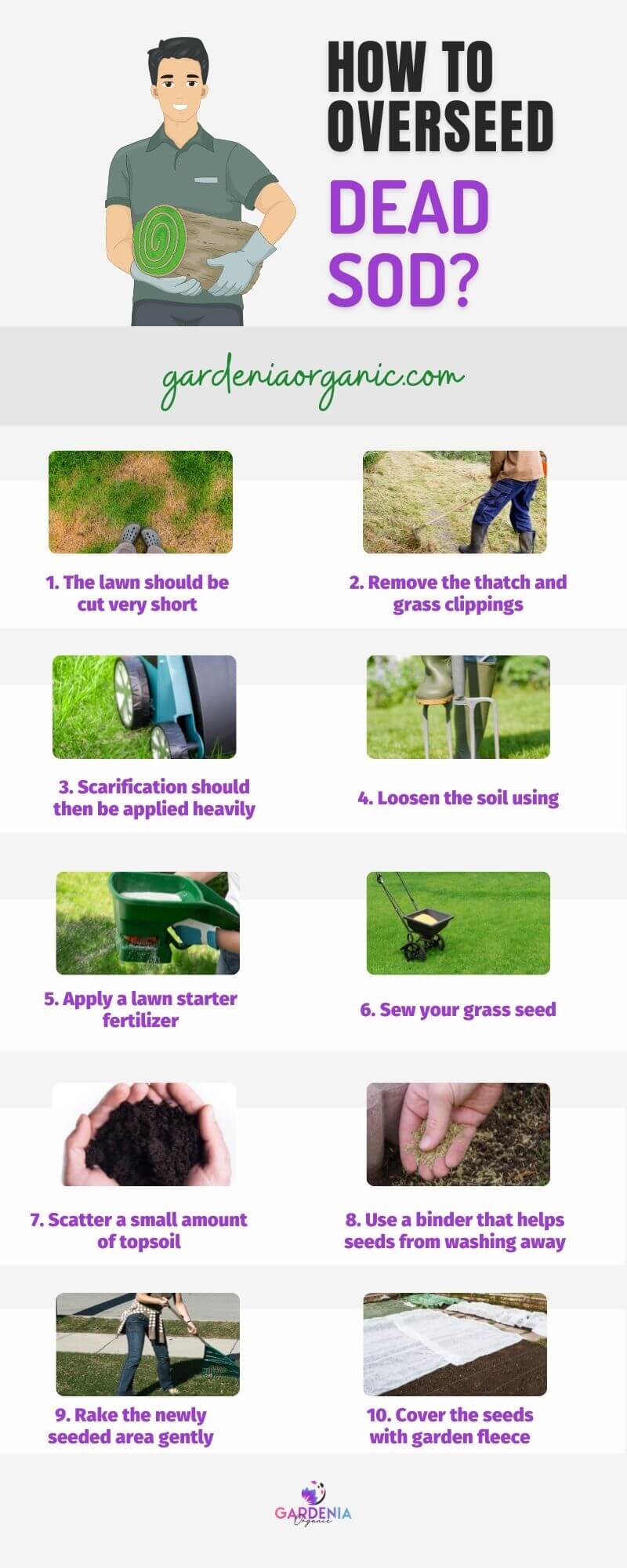Sod overseeding is planting grass seeds in an existing lawn without causing any significant structural changes to the turf.
Vacant and bare places in a yard are filled to thicken the lawn, improve its color, and establish new, hardy grass varieties in the lawn.
It is an excellent option for anyone whose lawn suffers from insect or disease damage, drought stress, or other signs of decline such as thin sparse grass, bare patches, or a lack of color.
If your grass has died, you have two options:
- lay new turf
- overseed the existing sod or turf
This could be because only a tiny area of your lawn is dead, making laying new turf unnecessary.

Overseeding your yard with unique, improved turfgrass varieties is frequently the most effective way to thicken it and enhance its health and appearance.
Newer turfgrass varieties are more resistant to diseases, drought, and lawn-damaging insects.
What to Consider Before Overseeding Dead Sod?
Excessive Moss Coverage
Excessive moss signifies other issues, such as excessive lawn thatch and soil compaction.
This will keep new grass seed from contacting the soil and, as a result, prevent it from germinating.
So, if you have a lot of moss on your lawn, you should get rid of it first. The best way to begin is to rake out as much as possible.
Then, before raking again, use a high-quality moss killer to kill any remaining moss.
Excess Lawn Thatch
Lawn thatch is the accumulation of dead organic material among the grassroots.
It consists of decomposing grassroots, old yard waste, and other organic matter.
Thatch is beneficial because it protects the cap of the grass plant from damage and disease.

However, too much can prevent air, water, and nutrients from penetrating the soil, causing grass growth to inhibit.
Because the thatch prevents contact between the new grass seed and the soil, it will not germinate.
Compaction of Soil
When you squeeze soil particles together, air, water, and nutrients are pushed out, making it difficult for them to get into the soil.
It also creates new grass seeds hard to germinate because they cannot grow roots in such hard soil.
Hollow-tine aeration allows soil particles to relax and loosen up from one another.
This allows air, water, and nutrients to penetrate the ground, making it easier for grassroots to grow and establish themselves.
Condition of the Soil
Grass is a tough plant that can grow even in arid states.
However, if you have extremely heavy clay soil, adding sandy loam topsoil will help.
Similarly, if the soil is very sandy, a good quality loam topsoil will be beneficial.
At the very least, you should ensure that the soil has all of the nutrients it requires.
How to Overseed Dead Sod?

Step 1
The lawn should be cut very short.
Cut it on a high setting if your grass is long, removing only one-third of the length. Cut the grass again right away, but on a much lower setting this time.
Lowering the mowing height gradually will prevent the damaging of the excellent sod.
Step 2
Remove the thatch and grass clippings with a rake.
Thatch is a layer mostly of decaying organic matter on the soil’s surface. After mowing your lawn, you must also remove all grass clippings.
A thick layer of thatch or cut grass will prevent seeds from germinating because seeds require direct contact with soil to germinate.
Step 3
Scarification should then be applied heavily.
If grass seed is lying on dead grass, it will not germinate. Heavy scarification will ensure that the soil is exposed and that the dead grass is removed.
Step 4
Loosen the soil using the most suitable way for your soil’s compactness.
Heavy raking, aerating, Roto-tilling, or using a dethatching machine are all options for loosening the soil.
Step 5
Apply a lawn starter fertilizer to help the new grass get to a good start.
Some grass seeds are pre-treated with their starter fertilizer. Check the packaging to see if your grass seed includes a starter fertilizer.
Step 6
Either by hand or with a mechanical spreader, sew your grass seed.
Don’t be afraid to put down more grass seed than you think you’ll need.
Because grass seed is relatively inexpensive, throw more of it down to compensate for the seed that will not germinate.
Step 7
Scatter a small amount of topsoil over the seed.
This layer should not be more than a few millimeters thick. Consider yourself to be dusting the new seed with topsoil.
Step 8
If the overseeding area is small, use a binder that helps seeds from washing away.
This includes its blend of seeds, fertilizer, and soil mixture to aid in germination.
The growing medium aims to keep the seed moist. With this product, seed germination is extremely fast.
Step 9
Rake the newly seeded area gently to help the seeds settle into the soil.
Keep in mind that seeds that are not in direct contact with soil will not germinate.
Step 10
Cover the seeds with garden fleece to keep birds from eating them.
It will also raise the surface temperature and hasten the germination process. Remove the fleece once the seed has germinated.
| What to do before overseeding | What to do after overseeding |
|---|---|
| Examine your lawn for the presence of thatch | Water the lawn immediately after overseeding to help grass seed settle into slits or aeration holes. |
| Aerate your lawn if it is too dense | Before grass seeds germinate, water the lawn lightly every day for one to two weeks |
| Remove the thatch and dead grass from your lawn | After the grass seeds germinate, gradually reduce the frequency and depth of watering |
| Cut the grass short with your mower on the lowest setting. | On your first mow, bag the clippings and don’t cut more than 1/3 of the new grass blade |
| Remove the clippings so that the grass seed can be viable | Regular lawn irrigation, mowing, and maintenance can resume after your first mow. |
| Rake your lawn to loosen the top layer of soil. |
Why You Should Overseed Dead Sod?
A beautiful lawn does not grow by chance or over time.
The key to having a lush, green lawn is to put in the effort.
By conducting a set of landscaping projects at the right time of year, you can have the yard of your fantasies in a season or two.
Overseeding your lawn is something that almost everyone recommends.
There are numerous advantages to overseeding your lawn:
- Overseeding mainly aims for the rejuvenation of worn-out lawns. It is a simple way to restore a lawn to a healthy state lush, thick, and green without buying a new sod or starting from scratch.
- Spreading seed on an established lawn can strengthen it against insects, drought, illnesses, and other harsh conditions that may be causing your lawn to struggle.
- Overseeding is a natural and cost-effective method of reducing pesticide, fertilizer, and water use.
- Overseeding improves the color and consistency of your lawn. It can also help to avoid weed growth by thickening your lawn’s canopy and preventing light from reaching the soil.
Is There a Specific Time to Overseed Dead Sod?
Choosing the right time of year to perform the task is critical to increasing your chances of success in replacing dead grass in your lawn with healthy new grass.
Your location determines the ideal time to overseed your lawn.
The best time to overseed in cooler northern climates is late summer to early fall:
- This is because the weather will most likely be mild and not too hot.
- The soil is warm enough to endorse germination in the fall, but the temperatures aren’t too cold for the delicate new grass to develop before winter arrives.
- Weeds will not be as vigorous as they would have been in the spring and summer.
- There will be more rain than in the summer, which will keep your seed moist and thus allow it to germinate.
If not completed in the fall, do so as soon as possible to give seedlings sufficient time to establish before the summer heat arrives.
If you can’t overseed the sod in the early fall, the next best time is in the middle of spring.
Wait until the grass has begun to grow.
Let’s Face It: Summer overseeding is difficult because the weather is usually too hot to keep the seeds damp. Because weeds are actively growing, your seed will compete for resources with the weeds around it. This is a battle that the weeds will eventually win.
What to Do after Overseeding Your Sod?
To encourage germination, keep your lawn moist after overseeding.
This is simple if you have a watering system. Otherwise, you’ll have to use a sprinkler or hand-water in smaller areas.
Don’t stop watering once you see seedlings appear. These tiny seedlings require care during their first eight weeks.
They can start drying out and die if they do not have a mature root system.
It is not necessary to apply a starter fertilizer when overseeding. If you usually fertilize your lawn, there are enough nutrients in the soil to support the growth of the new seed.
After overseeding, applying fertilizer to your lawn can increase competition from mature grass, making it hard for new seedlings to establish.
Final Thoughts
Overseeding is a technique for thickening thin and patchy areas of a lawn.
It is also known as reseeding. Lawns must be restored regularly, and selecting the right grass seed for the task is very important.
Early fall is unquestionably the best time to overseed your lawn. August 15 to September 15 is the absolute peak for most northern regions of the United States.
During this period, daytime temperatures are still warm enough to encourage growth and nights become more relaxed, providing relief from the heat for new seedlings.
Soil temperatures are also ideal, resulting in faster seed germination.
You Might Also Like
- Starting a Lawn Care Business? 50 Lawn Care Business Names
- Do Green Roofs Need Drainage?
- 8 Cheap Ways to Cover Dirt in Your Backyard


